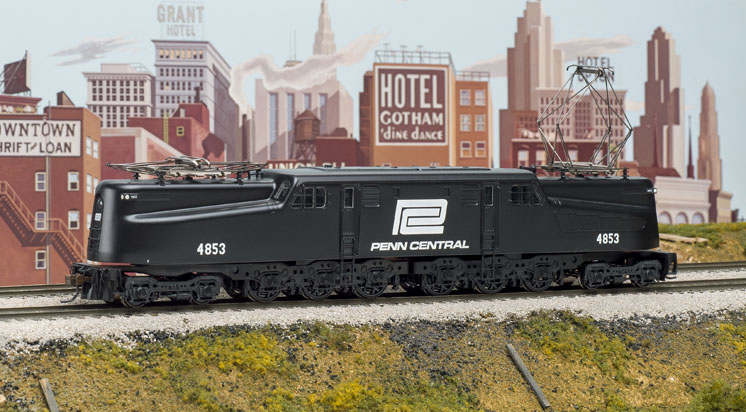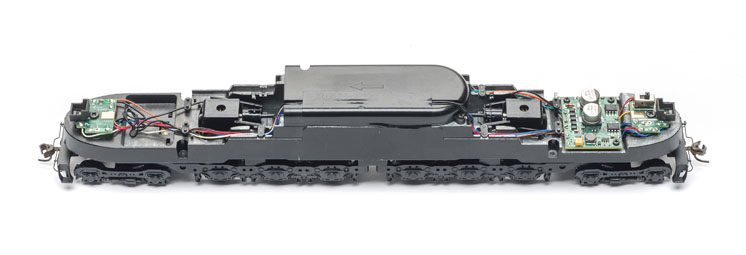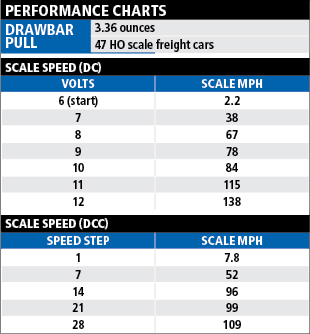GG1s have been riding the model rails almost as long as they did the prototype railroads. Bachmann Trains has added an HO scale model of Raymond Loewy’s Pennsylvania RR masterpiece to their Sound Value line. The dual-mode-decoder-equipped model operates with sound on direct-current (DC) and Digital Command Control (DCC) layouts.
Well-documented prototype. The GG1 has been well-documented over the years, so I’ll hit the highlights of this classic heavy electric. Built from 1934 to 1943, the 139-unit fleet was erected at PRR’s Altoona shops, with the exception of the first 15 locomotives, built by General Electric (GE). Major castings came from Baldwin subsidiary General Steel Castings, and electrical equipment came from GE and Westinghouse.
The first 58 locomotives had flat steel pilots with rigidly mounted couplers. After January 1937, rounded pilots with drop couplers were installed. All except the first locomotive, no. 4800 known as “Rivets,” had Loewy’s welded steel streamlined body design.
By the 1950s, shrinking passenger schedules saw the GG1s, which were built to haul 18-car passenger trains at 90 mph, taking over freight duties from the P5a electrics they had previously displaced from passenger duty.
The GG1s outlasted the PRR and successor Penn Central, eventually hauling freight for Conrail. Amtrak and New Jersey Transit used them in passenger service until 1981 and 1983, respectively. Several examples have been preserved in non-operating condition.
Well-proportioned model. Bachmann’s GG1 features an injection-molded plastic body shell attached to a die-cast metal frame. The body shell captures the overall look of the prototype’s styling well. Factory-applied detail parts include wire grab irons and cab window guards, windshield wipers, horns, and cab steps.
The pantographs are chemically blackened wire with metal shoes and bases. A switch mounted inside the locomotive on the frame allows owners to select overhead power pickup, if desired.
All dimensions were within scale inches of drawings in the October 1994 Model Railroader. Our sample was painted in Penn Central basic black. The coverage was even and smooth, and the Penn Central “worms” herald, lettering, and road numbers were all sharp and opaque. Based on its road number, this locomotive should have a flat pilot instead of the rounded, drop-coupler pilot on the model.
Into the depths. To remove the body shell, I removed four screws in the frame between the power trucks and pilot trucks. Then I spread the center of the body, allowing it to lift free of the frame.
The flywheel-equipped motor powers the 12 scale 57″ drivers through a pair of gear towers, similar to a six-axle diesel locomotive. The drivers, which each pick up current from the rails, have significant lateral movement to allow negotiation of tight model railroad curves. This results in a noticeable gap between the sideframes and wheels, as well as the flattening of some sideframe detail.
The power trucks are part of a two-piece subframe, similar to the construction of the prototype GG1. On the prototype, the subframes are hinged together at the center of the locomotive. On the model, the subframes pivot on a mount between the first and second driver axle.
The four-wheel pilot trucks are mounted to the forward arms of the power truck subframes. The pilot castings are part of the subframe casting, similar to the prototype’s construction.
The Sound Value dual-mode decoder features audio files by SoundTraxx. The downward-facing speaker is housed in an enclosure on top of the motor. Surface-mount light-emitting diodes (LEDs) on small printed-circuit (PC) boards at each end of the frame illuminate the locomotive lights. A pad on these boards contacts a brass arm connected to the pantographs.
On the test track, Bachmann’s GG1 started making the sounds of an air compressor and blower motors at 6V DC, then just above that voltage started to move at about 2 scale mph after making two horn blasts. The locomotive’s bell rang until I reached 6.5V on the powerpack, about 13 scale mph.
Top speed at 12V was 138 scale mph, a bit higher than prototype. Drawbar pull was 3.36 ounces, equivalent to 47 HO scale freight cars.
Using DCC, the locomotive started moving at 7.8 scale mph in speed step 1, and reached a top speed of 109 scale mph in speed step 28. Using 128 speed steps brought the speed down to 2.6 scale mph in speed step 1.
On our Milwaukee, Racine & Troy staff layout, the 1 pound, 4.7 ounce GG1 threw its weight around, pulling 12 freight cars up a 3 percent grade. The horn had that loud blat I recall from hearing GG1s at grade crossings.
Besides the horn function, users can trigger the sound of the pneumatically operated pantographs being raised or lowered using function button 4, the sound of traction motor blowers with F5, or the sound of the compressor building air pressure for the brakes with F6. Press F1 to ring the bell. The headlights are directional, bright in the direction of travel and dim in the opposite direction.
I changed the lighting programming to give me manual control. I set the headlight to turn on and off with F0, and the rear light to turn on and off with F1. I then remapped the bell to F9.
For the lights, I set configuration variables (CVs) 33 and 34 to 1. This made sure the headlight would turn on and off with a push of F0. Then I set CV35 to a value of 2, which made F1 the function button for the rear light. Setting CV49 and 50 to a value of 145 allowed the dimmer on F7 to work. Setting CV39 (F5) to 1 and CV43 to 8 moved the bell to F9.
I also added momentum to the acceleration rate on CV3, increasing the value from 6 to 50. Likewise, I increased the value of CV4, the deceleration rate, to 30. You may want to add more.
The prototype GG1s made a strong impression on me as a youngster at trackside, and Bachmann’s model has brought back that feeling of power and grace. Whether you want to model the high-density traffic of the New York-to-Washington PRR main line or are just a fan of timeless industrial design, Bachmann’s GG1 should serve your needs well.
Manufacturer
Bachmann Industries
1400 E. Erie Ave.
Philadelphia, PA 19124
www.bachmanntrains.com
Era: 1968 to 1976 as decorated
Road names: Penn Central, Amtrak, Pennsylvania RR (Brunswick green 5-stripe, Tuscan red 5-stripe, Brunswick green single stripe, Congressional silver with red stripe)
Features
12-wheel drive
Die-cast metal frame
Plastic knuckle couplers, at correct height
Weight: 20.7 ounces
















